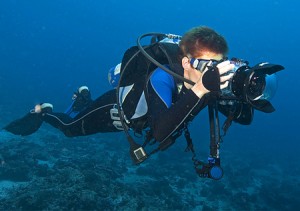Last week, we looked at some tips to help novice divers become acquainted with taking underwater photographs while still remaining safe. These tips mostly focused on minimising the risk to the diver and others in the group; this is mainly because people who have not completed a dive course do not have the necessary knowledge and skills to be more independent with underwater cameras. For certified divers, safety is still the main priority, but more liberties can be taken while using a camera underwater. So we’ve compiled a list of tips to help both newly certified and experienced divers alike capture those amazing underwater shots.
Tip #1: Get Up Close and Personal
Get close to your subject, preferably within 30 centimetres. Trying to photograph something small like a nudibranch or clownfish requires the lens to get as close as possible to the subject, otherwise a lot of detail will be lost. Many action cameras come with extension sticks that can make it so you don’t scare the animal away or interfere with its habitat. Remember to be aware of your body position, so you don’t kick the coral. While we’re on the topic of body position…
Tip #2: Master the Art of the Hover
Stirring up the sandy bottom releases particles that can cause poor visibility, and when filming, this can translate as backscatter. Backscatter is mainly caused by strobes or the internal flash lighting up particles in the water in between the lens and the subject. It can also be caused by lighting up open water directly behind a subject. Master buoyancy and only dive near other divers with good buoyancy who won’t stir up the bottom. Be careful of stirring up particulate matter yourself. Sometimes you may not realize that your fins are stirring up the bottom or the elbow or even finger that you use to brace yourself against the bottom is actually stirring up particulate matter from the sand.
Tip #3: Know Thy Equipment (and it’s limits)
Just as different paintbrushes produce different brush strokes, different cameras, lenses, lights and equipment produce different photos. Know how to use your equipment before you jump in the water, and know your equipment’s limitations. A GoPro is not going to get as good an up-close photo of a clownfish as DSLR camera with macro lens and an underwater housing and strobe lights. As long as you know what kind of photos your camera is best suited for, you’ll never be disappointed.

